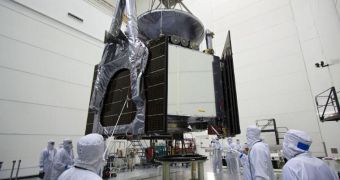Engineers are continuing to get the NASA Juno spacecraft ready for launch later this year. Just a couple of days ago, they completed the integration process, which means that the probe is now safely tucked away inside its payload fairing.
The device helps protect the vehicle during the harsh ascent to Earth's orbit, experts explain. Once the probe reaches appropriate altitudes, the fairing will be ejected, and Juno exposed to the rigorous conditions of its new operating environment.
Though it will only remain attached for the first 205 seconds of flight, the fairing is a critical part of the mission. In fact, all satellites and telescopes being launched from the planetary surface are protected during their trek to orbit.
Juno is heading towards Jupiter, where it will spend some time analyzing the gas giant's surface, atmosphere, magnetosphere, gravitational pull, chemical composition and so on. It will carry out a total of 33 orbits around the planet.
Before the encapsulation operation began, experts inspected a series of electrical connections on the probe, on Friday, July 15. The topics of interest were the links between the spacecraft and one of its two magnetometers.
In order to get the most relevant results, the study team used an investigations method called gamma-ray radiography. They determined that the wires were perfectly capable of relaying the amount of heat needed to keep the instrument running in space.
“This test gave us confidence that our magnetometer will work as advertised in just about the harshest environment you could find in the solar system,” explains the principal investigator of the Juno mission, Scott Bolton. He is based at the Southwest Research Institute (SwRI), in San Antonio, Texas.
NASA wants to launch the spacecraft in just two weeks. A launch window opens on August 5 and extends all the way through August 26. At this time, everything is looking great, and experts have no reason to believe that Juno will remain grounded beyond August.
“The Juno spacecraft carries two redundant Flux Gate Magnetometer instruments that will measure Jupiter's powerful magnetic environment,” a press release from the NASA Jet Propulsion Laboratory (JPL), in Pasadena, California, reads.
“Lab testing of heaters similar to ones on Juno, designed to keep the Flux Gate Magnetometer instruments warm in space, had indicated a small probability that wire connections might not operate as expected,” the document adds.
“As a precaution, NASA and Juno mission personnel had decided to inspect the Juno heater elements and, if necessary, repair solder joints connecting the heaters' electrical wires to their mounting surfaces to ensure mission success,” the release explains.
JPL – a division of the California Institute of Technology – is managing Juno for NASA.

 14 DAY TRIAL //
14 DAY TRIAL //